Corporations are learning about the way our brains respond to advertising, and they’re finding out that they don’t work the way we think they do. And that’s just the way the advertisers want it.
advertising

Top 5 Super Bowl Ads (With Video)
The Consumerist’s picks for the top five best SuperBowl 2007 ads:

Free Food For You If K-Fed Agrees To Work At Taco Bell For An Hour
The curiously Australian president of Taco Bell, Greg Creed, has invited (via open letter) one “Kevin Federline” to work at Taco Bell for the period of one hour. If the soon-to-be-former Mr. Britney Spears agrees, anyone who comes to the Taco Bell to watch will receive “an order of our new Carne Asada Steak Grilled Taquitos for free.” The letter comes in response to a statement K-Fed made about his children working at Taco Bell. Read the letter inside.
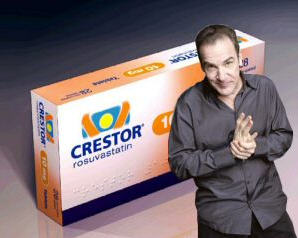
Are Drug Commercials Bad For Your Health?
“Most ads (82%) made some factual claims and made rational arguments (86%) for product use, but few described condition causes (26%), risk factors (26%), or prevalence (25%). Emotional appeals were almost universal (95%). No ads mentioned lifestyle change as an alternative to products, though some (19%) portrayed it as an adjunct to medication. Some ads (18%) portrayed lifestyle changes as insufficient for controlling a condition. The ads often framed medication use in terms of losing (58%) and regaining control (85%) over some aspect of life and as engendering social approval (78%). Products were frequently (58%) portrayed as a medical breakthrough.”
The researchers determined that big pharma advertisements don’t provide much factual information and Instead, rely on “characters that have lost control over their social, emotional, or physical lives without the medication.” We’re not scientists or anything, but we’ve noticed this too. —MEGHANN MARCO
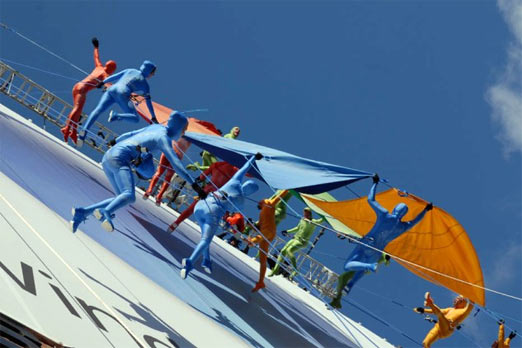
Did Microsoft's Vista Circus Promo Break NYC Law?
Yesterday’s fanciful Windows Vista promotion featured thirteen unitard clad abseilers racing down the Terminal Building, waving gaily colored flags to form the Vista logo. It may also have been completely illegal according to NYC Admin Code.
Priceline, Travelocity and Cingular Settle Over Adware Charges
This settlement marks the first time the advertisers have been held responsible for how their ads were delivered. “Advertisers can no longer insulate themselves from liability by turning a blind eye to how their advertisements are delivered, or by placing ads through intermediaries, such as media buyers,” a statement from the New York Attorney General’s Office said. “The settlement calls for Priceline.com, Travelocity and Cingular, the wireless unit of AT&T, to pay New York $35,000, $30,000 and $35,000, respectively, to cover penalties and investigatory costs.” Is $35,000 enough to make a company think twice? —MEGHANN MARCO
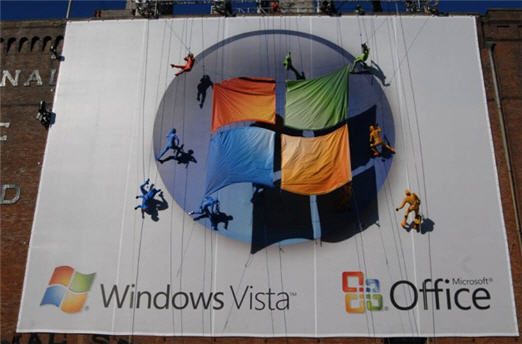
Microsoft's Vista Circus: Was David Blaine Busy?
Gothamist has evidence of some “off the wall” advertising by Microsoft. In celebration of the imminent Vista launch, they set up a special billboard in Manhattan…then circus performers encased in colorful scuba diving suits repelled down the surface, hailed cabs and left. Yes, really. It kind of reminds us of that dance cycle guy from the Big Lebowski. Not sure if that was their intention.—MEGHANN MARCO

Super Bowl Ad Spoilers
Finally, this year there is a Super Bowl worth watching for the game, rather than the ads, which promise to be boring and lame. If you’d like to spoil them for yourself, check out USA Today.
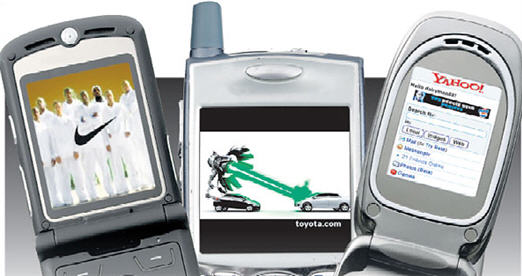
Cell Phones: The Ads Are Coming
- Cellular phone carriers like Verizon, Sprint and Cingular, now the new AT&T, are beginning to test and roll out advertising on mobile phone screens, and by next year, cellphone advertising is likely to be more common.
McDonald’s And Food Network: Subliminal Advertising?
Reader Janeka sends in this video from You Tube. Someone was watching Iron Chef America when they noticed their screen flash red, and when they went back to see what it was, they found a McDonald’s ad on just one frame! Oooh, scary!
Why Do You Hate The Gap?
- Earlier this month two key executives, Denise Johnston, president of Gap’s adult division, and Ivy Ross, head of product design for Old Navy, left the company, bringing to 10 the number of senior executives who have vacated key spots at the company, including Kyle Andrew, vp, marketing for the Gap brand.
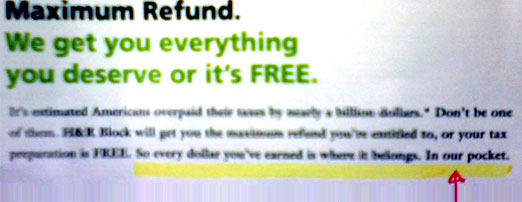
H&R Block’s Freudian Slip
The Consumerist has its fair share of typos, but at least we don’t make them in a fixed medium.
Walmart Commercial From 1981, Featuring “Cassette to Cassette” Copying
Copying music wasn’t always so taboo, here’s a Walmart commercial from 1981 that features a stereo system with the “special twin cassette feature.” Now you can record from cassette to cassette! Cool!
Chinese National Anthem to Used to Sell Wrigley Gum
Well, hey, the song is catchy. The Chinese certainly seem to like it. —MEGHANN MARCO
Airport Security Trays To Feature Advertisements
- Travelers nationwide could soon see ads for laptops, expensive cars and other products in the trays that carry their shoes and cell phones through X-ray machines at airport security checkpoints.

Say Goodbye To Cingular, Starting Monday
- Starting Monday, Jan. 15, AT&T Inc. (NYSE:T) is launching a new multi-media campaign to begin transitioning the Cingular brand to AT&T in advertising and customer communications, throughout Web sites and nationwide retail stores, and on company buildings and vehicles.
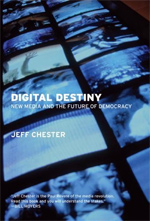
The Manchurian Consumer
A new book, Digital Destiny, accuses the ad industry of “brandwashing” America and warns of advertisers working behind the scenes to gut consumer’s online privacy. Ad Age writes:

How To: Tell If Images Were Faked
As a skeptical consumer, you’ve probably looked at photo in the news or a piece of advertising and thought, hey, I bet that was faked. Now with a little help from Photoshop, and Tim Mathenson’s tutorial, you can tell.


